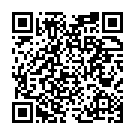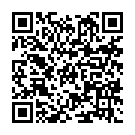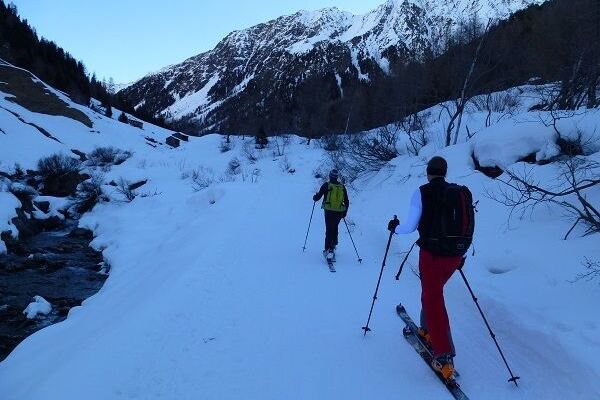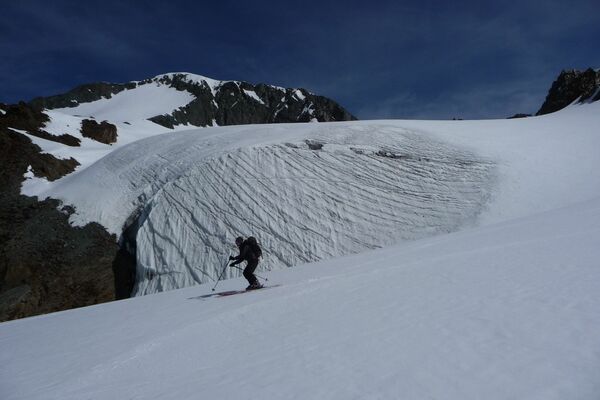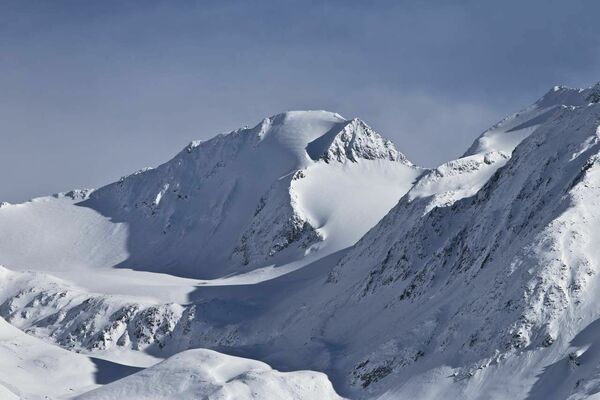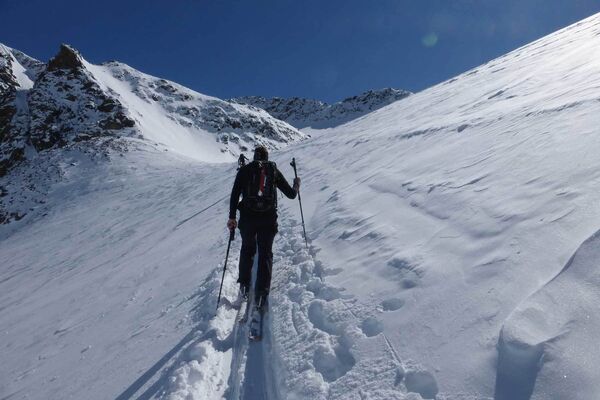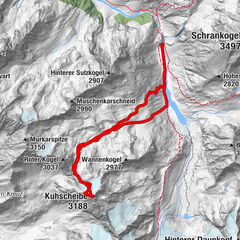
- Brief description
-
AMBERGER HÜTTE -> Sulztalferner -> Pockkar -> HINTERER DAUNKOPF
- Difficulty
-
medium
- Rating
-
- Route
-
Hinterer Daunkopf (3,225 m)6.1 km
- Best season
-
AugSepOctNovDecJanFebMarAprMayJunJul
- Description
-
The ascent to Amberger Hütte takes about 2 hours/500 altitude meters(overnight stay recommended). Through Sulze valley up to Sulztalfernerglacier. Keep to the left after the first steep climb - ascent toPockkar. At its end you walk to the right, crossing a steep terrace upto the peak slope and summit cross. Great view of the Stubai ski area,Sulztalferner, Hochstubaihütte!
- Directions
-
The ascent to Amberger Hütte takes about 2 hours/500 altitude meters(overnight stay recommended). Through Sulze valley up to Sulztalfernerglacier. Keep to the left after the first steep climb - ascent toPockkar. At its end you walk to the right, crossing a steep terrace upto the peak slope and summit cross. Great view of the Stubai ski area,Sulztalferner, Hochstubaihütte!
- Highest point
- 3,203 m
- Endpoint
-
Hinterer Daunkopf
- Exposition
- Height profile
-
- Equipment
-
Recommended Ski Mountaineering Equipment
The „standard ski mountaineering equipment“ is: touring skis with touring bindings, telescopic poles, climbing skins, ski crampons, digital avalanche transceiver, avalanche shovel, avalanche probe, firstaid kit and mobile phone. A „complete glacier equipment set“ contains: sit harness, two prusik loops of different lengths and ascenders, two HMS biners, icepick, climbing irons and rope. Pack your rucksack carefully and don‘t forget extra clothes for the descent, sun protection/cream, cold protection, enough food and drink. If you stay overnight at a mountain hut take toiletry articles and a hut sleeping bag with you!
LEVELS OF DIFFICULTY
Easy: Short or moderately long tours, always easy, with ascents not steeper than 25° or slightly steeper only on short sections. Intermediate: Moderately long or long tours of intermediate difficulty with ascents up to 35° or slightly steeper only on short sections. Difficult: Very challenging and long or very long tours with ascents that can exceed 40°, comprising also climbing sections up to difficulty grade II (UIAA). - Safety instructions
-
Avalanche Hazard Scale
1 (LOW) Triggering is generally possible but only from high additional load in isolated areas of extremely steep terrain. Only small-sized sluffs and natural avalanches are expected. Snow layers are generally stable.
2 (MODERATE) Avalanches may be triggered in case of truly heavy loads, especially on a few explicitly indicated, steep slopes. Large spontaneous avalanches are not expected. In general, the snowpack is well bonded except on some very steep slopes. Choose your route carefully, avoid the indicated slopes and exposed sections.
3 (CONSIDERABLE) Triggering is very probable even from low additional loads, particularly on the indicated steep slopes. On some steeper slopes, medium or even fairly large spontaneous avalanches may occur. On most steepslopes the snow layer is only moderately or weakly stable. Expertavalanche knowledge is required. You must avoid the indicated steepslopes and highly exposed sections.
4 (HIGH) Avalanches are likely to be triggered on many of the indicated steepslopes even if only light loads are applied. In some places, numerous medium-sized and also large-sized natural avalanches are expected.The snowpack is poorly bonded on most steep slopes. Choose your route according to these criteria, select only moderately steep terrain by avoiding the avalanche runout zones. Very expert avalanche knowledge is required.
5 (EXTREMELY HIGH) Numerous huge or very large-sized natural avalanches are expected also in moderately steep terrain. Safe skiing is not possible anymore, not even in the marked ski area. The snowpack is poorly bonded and largely unstable. Don‘t go ski mountaineering at all!
Always check the current avalanche danger level before setting out on a ski tour! A daily updated avalanche report is available (in the winter months) on the official website of Tirol's avalanche warning service www.lawine.tirol.gv.at
- Tips
-
An overnight stay at the Amberger Hut is recommended.
- Additional information
-
Ski Mountaineering Rules If you enjoy activities amid nature always respect the local guidelines when you set out on a ski tour (for example: wildlife preserves, hunting enclosures, reforestation areas, information boards, etc.). Don‘t enter protected wildlife zones or feeding areas amid naturelandscapes, and avoid noise. Cross forest areas in winter only on sign posted trails or marked routes as wild animals can panic if they hear loud voices or noise. Learn more about the habitat of wild animals in the mountains, avoid getting too close to them. Watch them only from a safe distance. Please put your dog on a lead, it is absolutely irresponsible to take dogs into the forest without leashing them because wild animals suffer from food deficiency and weakness in winter. Excellent planning and time management: start your tour early enough and return before darkness. In spring you should be back on the hut or in the valley at 12 noon (avalanche hazard!) at the latest. Never cross forestation zones and areas with young plants and trees.
Ötztal Tourismus doesn‘t take any responsibility for the suggested tours. It is strongly recommended to enlist a certified local mountainguide. Glacier crossings are allowed only in a group by using a rope.
Before you set out on a tour you should inform someone down in the valley about the tour‘s destination and when you plan to be back. Anavalanche transceiver is an absolute must for Alpine ski mountaineering tours.
More details about ski mountaineering tours in Ötztal: https://www.oetztal.com/skitouren
- Directions
- Public transportation
- Parking
-
The following parking facilities are available in Gries:
Gries at the end of the village - (chargeable)
- Author
-
The tour Hinterer Daunkopf is used by outdooractive.com provided.
General info
-
Ötztal
146
-
Stubaier Gletscher
37




